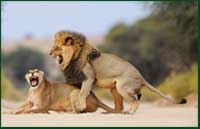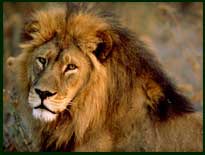Lion
Introduction
Page 1 of 6
The Indian lion, commonly called as 'King of the Jungle' is one of the five major big cats found in India. The Indian lions extended from the Mediterranean to the north-eastern parts of the Indian subcontinent. But their habitat was reduced due to excessive hunting, water pollution and decline in natural prey. Indian lions are smaller and lighter than their African counterparts, but are equally aggressive.
Habitat
The Indian lion is also known as the Asiatic lion or the Persian lion. Many years back this lion wandered freely from Asia Minor and Arabia through Persia to India. The Indian lions in the Indian sub-continent extended across northern India from the east, all the way to Bihar in the west, and river Narmada marking their habitat limit in the south. This lion disappeared from Bihar in 1840, from Delhi in 1834, from Rajasthan and Central India in 1870, from the Eastern Vindhyas & Bundelkhand in 1880 and from the Western Aravallis in 1880. The Indian lion was wiped off from its wide Indian habitat except from one particular area, the Gir Forest National Park and Wildlife Sanctuary in the state of Gujarat in India. Indian Lion desires grasslands, shrub and open deciduous forests.
Places Found:
Gir National Park:The Indian lion is now found only in the Gir National Park, Gujarat. There have been efforts made to move a small number of these lions to another park. However, these plans are yet to be put into action.
Page 2 of 6
Food Habits:
Their prey consists of Nilgai, Chital, Sambhar, Goats, Buffaloes and also other smaller animals. The lions of Gir kill livestock and sometimes even camels. In India, lions eat several different types of deer, as well as wild boar. Rhinoceros, hippos and elephants are too large, and lions usually attack these animals when starving.
A lioness needs to eat 11 pounds of meat a day; a male needs about 15.5 pounds of flesh.
Hunting and diet: Lions usually hunt in organized groups. Typically, several lionesses work together and enclose the herd from different points. Then they usually target the closest prey. Lionesses do maximum of the hunting; males attached to prides do not usually participate in hunting, except for larger target such as giraffe and buffalo. Young lions first display stalking behavior around three months of age, although they do not participate in hunting until they are almost a year old. They begin to hunt effectively when nearing the age of two.
Species of Lion:
Eight recent (Holocene) subspecies od Lion are recognized today:
Persica, known as the Asiatic lion or South Asian, Persian, or Indian Lion, once was widespread from Turkey, across Southwest Asia, to Pakistan, India, and even to Bangladesh. Now around 300 exist in and near the Gir Forests of India.
• Leo, known as the Barbary lion, originally extended from Morocco to Egypt. It vanished in the wild due to excessive hunting.
• Senegalensis, known as the West African Lion, is found in western Africa, from Senegal to the Central African Republic.
• Azandica, known as the Northeast Congo Lion, is found in the northeastern parts of Congo.
• Nubica, known as the East African, Massai Lion is found in east Africa, from Ethiopia and Kenya to Tanzania and Mozambique, a local population is known as Tsavo Lion.
• Bleyenberghi, known as the Southwest African or Katanga Lion, is found in southwestern Africa, Namibia, Botswana, Angola, Katanga (Zaire), Zambia, and Zimbabwe.
• Krugeri, known as the Southeast African Lion or Transvaal Lion, is found in the Transvaal region of southeastern Africa, including Kruger National Park. Melanochaita, known as the Cape lion, became destroyed in the wild around 1860.
Page 3 of 6
Mating Behaviour:
Most lionesses will have reproduced at four years of age. Lions reproduce very well in custody. The average growth period is around 110 days. Besides greater protection, the synchronization of births also has an advantage in that the cubs end up being roughly the same size, and thus have an equal chance of survival. If one lioness gives birth to a litter of cubs a couple of months after another lioness, for instance, then the younger cubs, being much smaller than their older brethren, are usually dominated by larger cubs at mealtimes consequently, death by starvation is more common amongst the younger cubs.
Physical Structure:
The lion's body is very muscular, with less bone mass.
The fore body of the lion is very powerfully built.
The bones of the front legs are twisted in such a manner as to give a great range of motion to the forelimb.
Each paw is equipped with soft pads to make its movements quiet.
The claws are retractable and very sharp. The body is covered with a sandy brown coat in most subspecies of lions.
The mature male lion has a mane that covers the backside of the head, and the shoulders. The eyes are proportionately larger than in other comparable-sized animals, and posses round pupils.
The sense of smell is well developed. Lions mark their territories by scent deposits, requiring a good sense of smell. The sense of hearing is perhaps only slightly above average.
The lion's tail is the only one in the cat family with a tassel at the tip. (Tigers also have a tassel, but they are not found in the wild.)
The lion's teeth are well adapted for killing their prey and eating it. The digestive system of the lion is simple, not unlike a human's. Meat is fairly easy to digest, and the elaborate digestive mechanisms present help them to break down the cellulose from their prey.
A lion's body temperature ranges from 100.5 to 102.5 degrees Fahrenheit. (38.05 - 39.16 degrees C.) It is believed that the roar serves to alert other lions of an individual's presence.
Page 4 of 6
Lion Population in the world:
Most of lion population is found in tropical Africa.
Twenty years back the lion's population in Africa was about 200,000 but as years went on we have only 23,000 lion's today.
Population and Statistics
| Details of Apr-2010 Census |
| Area wise Distribution |
| AREA |
Male |
Female |
Cubs |
Total |
| Gir National Park & adjoining |
59 |
121 |
117 |
297 |
| Girnar Sanctuary |
7 |
11 |
6 |
24 |
| Mityala Sanctuary |
2 |
3 |
2 |
7 |
| Paniya Sanctuary |
3 |
6 |
0 |
9 |
| Coastal areas (Una, Kodinar, Sutrapada, and Chhara) |
9 |
6 |
6 |
21 |
| Savarkundla, Liliya and adjoining areas of Amreli and Bhavnagar |
17 |
15 |
21 |
53 |
| T O T A L |
97 |
162 |
152 |
411 |
| |
| District wise Distribution |
| District |
Male |
Female |
Cubs |
Total |
| Junagadh |
58 |
111 |
101 |
270 |
| Amreli |
28 |
40 |
40 |
108 |
| Bhavnagar |
11 |
11 |
11 |
33 |
| T O T A L |
97 |
162 |
152 |
411 |
Page 5 of 6
Lion Population Table:
| Region |
Minimum |
Estimated |
Maximum |
% of Estimated Lions per Region |
| ASIATIC LION |
| India (Gir National Forest) |
200 |
327 |
350 |
100% of Wild Asiatic Lions |
| SSP/EEP (Captive Bred) |
82* |
82 |
82 |
100% of Captive Bred SSP/EEP Asiatic Lions |
Conservation Effort in India:
Conservation efforts for Indian Lion were started in the year 1910. The Nawab of Junagadh executed a ban on the hunting of lions within his region. In 1960's and 1970's, Gir forest was converted into a National Park and Sanctuary. At present, Kuno Project is being undertaken to reduce the overcrowding at Gir.
The major threats that the Indian lions are facing are by the humans living near the sanctuary. It has become essential to include people in the conservation efforts. The park borders can be combined to avoid the human-lion clash. One of the greatest threats to the life of the lions is from poachers. The environment of Gir National Park also needs to be protected. The afforestation programs in Gir needs to be avoided.
Page 6 of 6
Mythology:
Buddha Shakyamuni: is at times called Lion of the Shakya and he is thus portrayed to be seated on a lion throne.
Qadesh or Qetesh: the Egyptian goddess of love, and beauty was commonly represented uncovered and standing or riding on a lion. The lion is also the vahana of Devi, India's Great Goddess.
Sakhmet or Sekhmet: is the lion-headed form of the Egyptian goddess Hathor in her appearance as demolisher. According to Chinese architecture two lions located outside homes and institutions act as protectors/guardians.
Lion in National Emblem :
Lion takes its part in the national emblem of India. The emblem is a part of the official letterhead of the Government of India, and also you can find it in all Indian currency. It also appears highly on the national Passport of the Republic of India.
Interesting Facts about Lions :
1. Lions are usually seen in groups with 3 or more animals living socially or together with their family and the groups are commonly addressed as 'Prides'.
2. A grown male lion may be 9 feet long. Lionesses are not the greatest successful of hunters. They generally score only one kill from several attempts. The males eat first, and then the lionesses and the cubs are the last.
3. The roar sound of a lion can reach one's ears 5 miles away.






